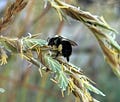The first time I ever saw sea oats was in a painting. My grandmother was a watercolorist, and she loved to paint the sand dunes along our South Carolina beaches. I suppose I didn’t know the sea oats were always waving in the wind, but her paintings made them feel alive, so when I saw sea oats at the beach for the first time, it was like seeing an old friend.
This year though, I saw something new. During our annual beach trip, I made my way out for a swim. Along the stairs leading down to the beach were the sea oats, as I expected. I paused to watch them dance, like they did in Meme’s paintings. In doing so, I noticed they were in full bloom, and their blooms were covered with a surprise - bumble bees. The bees weren’t just passing through either. They were focused, persistent, and patient, like my grandmother in her studio. The evidence for this was all over their hind legs, where the pollen baskets were fully loaded.
Why is this a surprise? Because grasses in general are mostly known for being wind-pollinated. Indeed, in all the references I can find, sea oats are so declared.1 Insects are not given any credit, as they are more associated with colorful flowers. But, grasses have flowers too, even if absent of the showy sepals and petals we commonly consider. Grasses don’t offer any nectar reward either, but they do have the reproductive parts that qualify them as flowering plants. Most importantly for the bumble bees, grasses have pollen, an amazing adaptation that aids in sperm transfer. The bee is after it for its protein, which their developing larvae need to grow and bumble like their parents one day.
Scientists are performing some incredible work on sea oats. As most beachgoers have probably noticed, it is often planted to control erosion. Not long ago, on the same beach I visit, there were sea oat sprouts, planted in a grid on artificial sand deposits. Now those sea oats have grown into adults. Sea oats help make dunes because they interrupt the flow of the windblown sand. Sand stops and starts to accumulate, thanks to the interference of the sea oat stems and leaves. The cumulative effect of these dunes can offer substantial protection against storms, including the hurricanes that frequent our shores. 2
To make the introduction of sea oats onto bare sands more successful, scientists start the sea oats in a nursery. This is important for several reasons - one is the ability to successfully innoculate the roots of sea oats with symbiotic fungi. Most plants on earth partner with fungi, especially in their roots. The fungi are given a place to stay and some carbon from the plant’s photosynthetic activities. In return, the fungi perform all kinds of favors. They can adorn the roots with their tiny bodies in a way that adds surface area to the root, which in turn allows for greater absorption of water and nutrients, like nitrogen and phosphorus.
More impressively, this symbiosis can help plants like sea oats deal with salty soils. The fungal partner increases the capacities of the plant, including water and nutrient uptake that may be needed under stress, but the fungi also involve themselves in the plant’s hormone regulation, stomatal control, and antioxidant production.3 There are several different fungi species involved, and they are tiny, reproducing in ways other than the mushrooms we associate with fungi reproduction. Consequently, you won’t notice their fruiting bodies on the dunes.
I don’t think I noticed bumble bees in my grandmother’s paintings. Maybe artists of today can add them to their work. Some dancers need a partner - I suppose - and though it didn’t immediately fit my construct for sea oats, I’m glad they aren’t dancing alone on the dunes. They have the fungi below and the bees up above and together, they make a sweet synchrony on the sand dunes of South Carolina.
See you out there, Austin
***If you learned something, pass it on. By the way, if you are interested, we have a few spots left in the Carolina bay class and the spider class. ***
Lonard, R. I., Judd, F. W., & Stalter, R. (2011). Biological Flora of Coastal Dunes and Wetlands: Uniola paniculata L. Journal of Coastal Research, 27(5), 984–993. https://doi.org/10.2112/JCOASTRES-D-10-00167.1
Feagin, R.A.; Smith, W.K.; Psuty, N.P.; Young, D.R.; Martı´nez, M.L.; Carter, G.A.; Lucas, K.L.; Gibeaut, J.C.; Gemma, J.N., and Koske, R.E., 2010. Barrier islands: Coupling anthropogenic stability with ecological sustainability. Journal of Coastal Research, 26(6), 987– 992.
Dastogeer, K. M. G., Zahan, M. I., Tahjib-Ul-Arif, M., Akter, M. A., & Okazaki, S. (2020). Plant Salinity Tolerance Conferred by Arbuscular Mycorrhizal Fungi and Associated Mechanisms: A Meta-Analysis. Frontiers in Plant Science, 11, 588550–588550. https://doi.org/10.3389/fpls.2020.588550




Nice! I love sea oats, when in full bloom, against a back drop of white sand, blue water. Next time I see the sea oats in bloom, I will definitely keep a look out for the humble bumbles on the flowers.
Years ago, when rambling through a longleaf pine savannah on the Francis Marion NF, I noticed bees collecting pollen from the flowers of toothache grass (Ctenium aromaticum). So I guess even though grasses are primarily wind pollinated, at least some species of grasses get additional help from the bees.